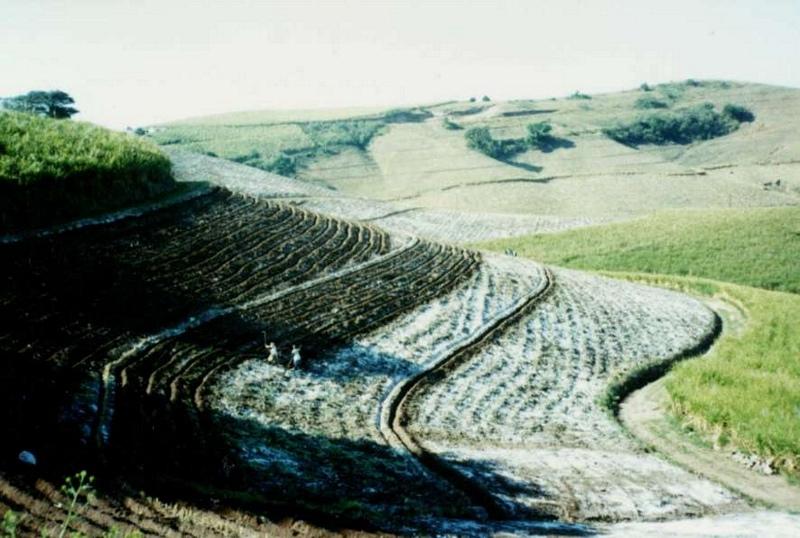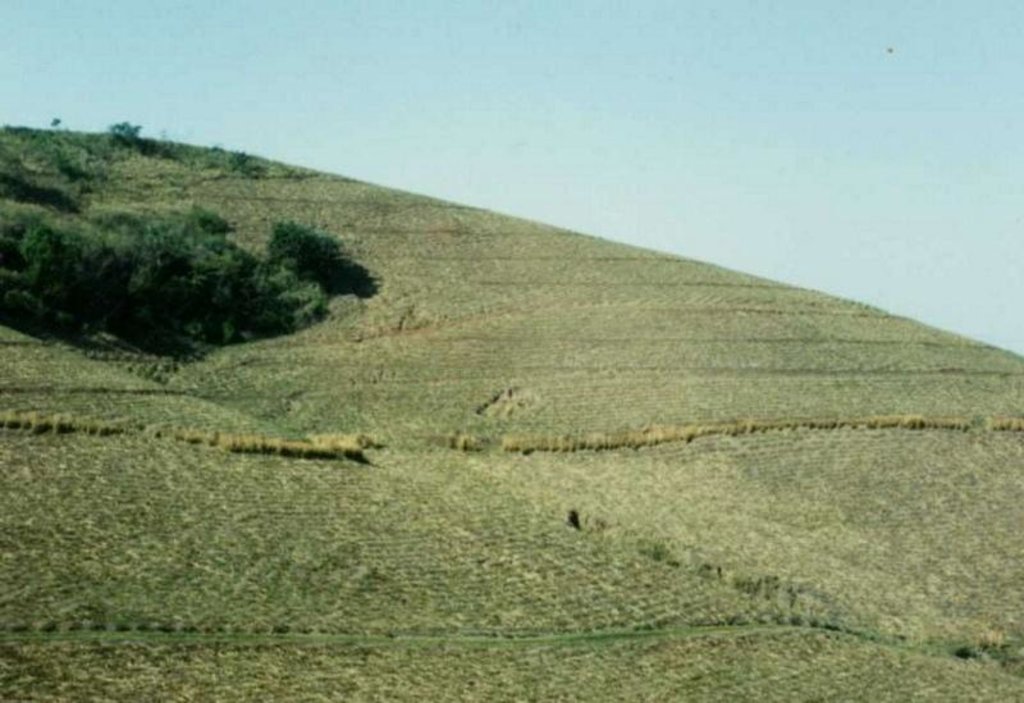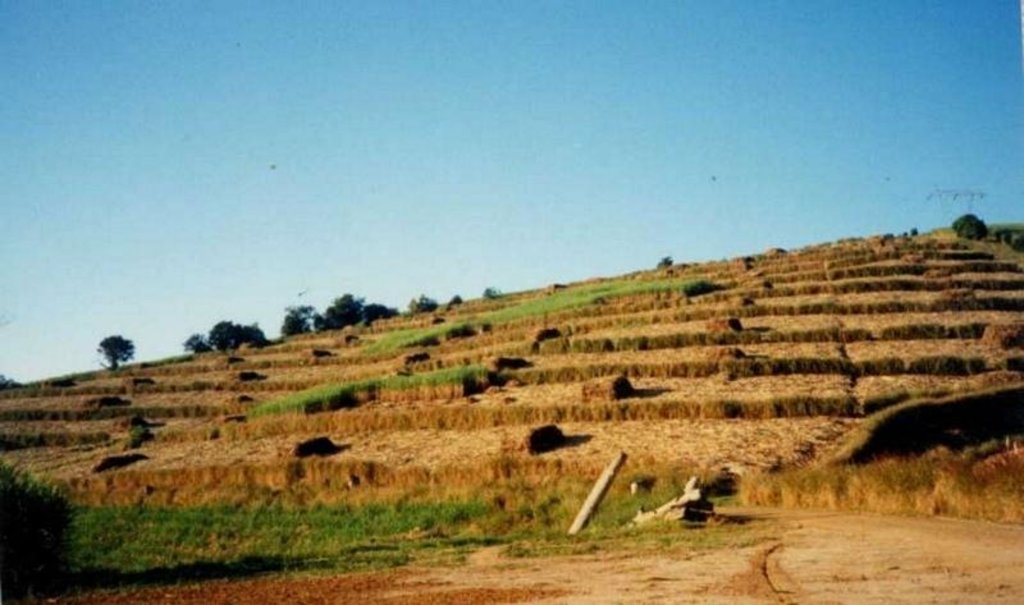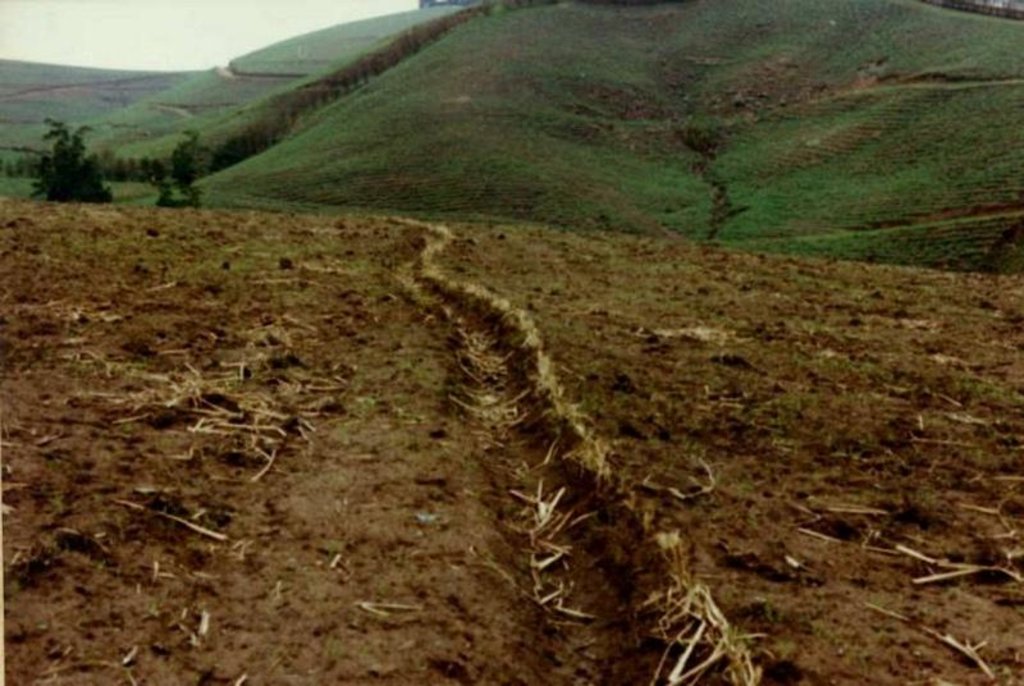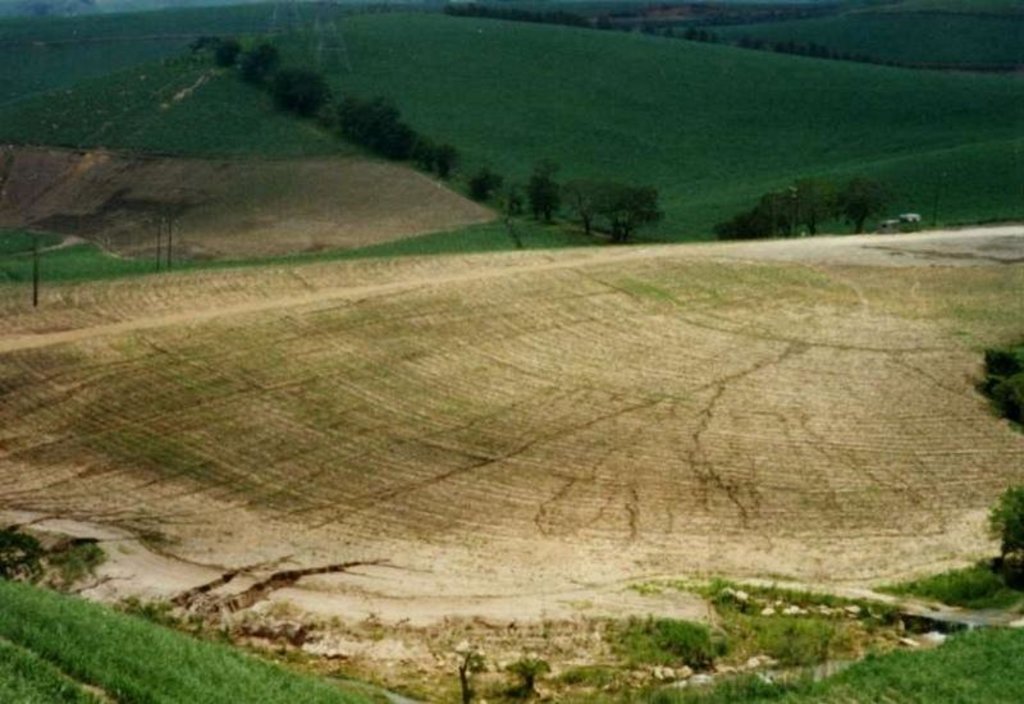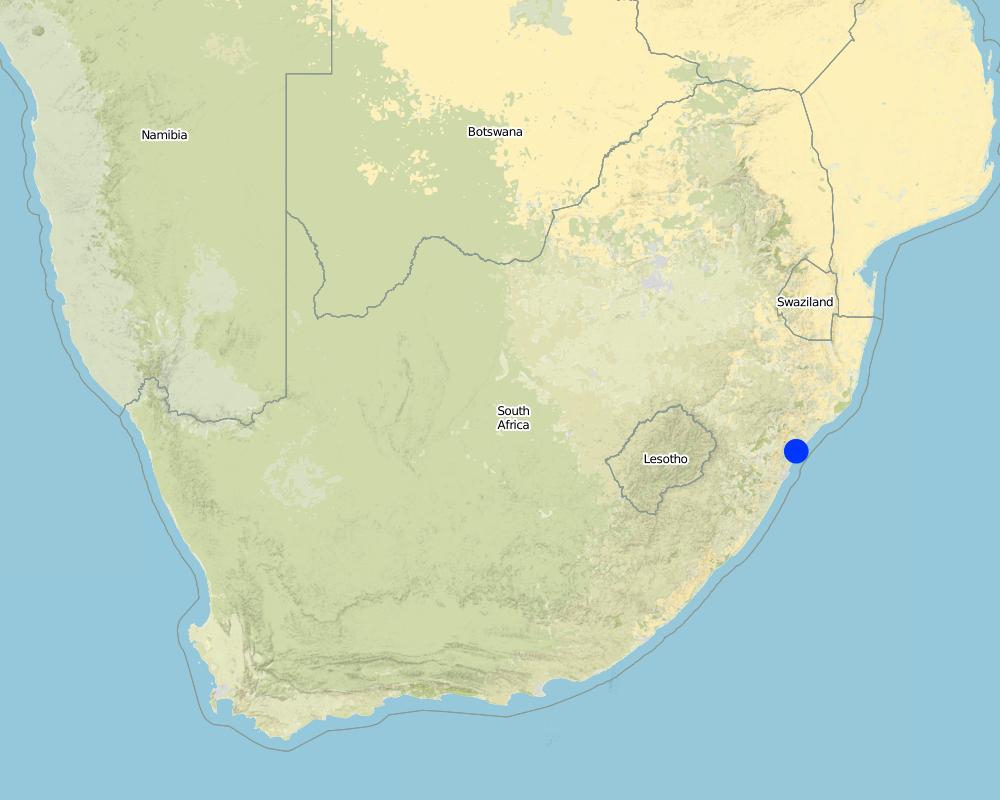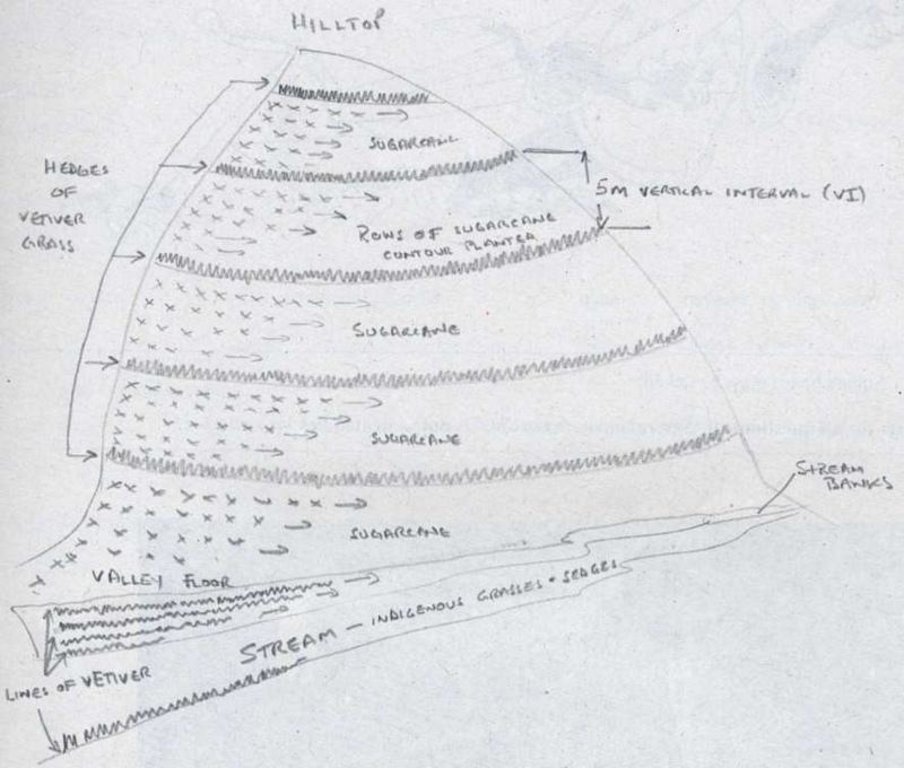Vetiver grass soil conservation system [África do Sul]
- Criação:
- Atualização:
- Compilador/a: Unknown User
- Editor: –
- Revisores: David Streiff, Alexandra Gavilano, Deborah Niggli
Vetiver system
technologies_938 - África do Sul
Veja as seções
Expandir tudo Recolher tudo1. Informação geral
1.2 Detalhes do contato das pessoas capacitadas e instituições envolvidas na avaliação e documentação da tecnologia
Pessoa(s) capacitada(s)
usuário de terra:
Stranic Rowan
031 593205
South African Sugar Association
Private Bag X02, Mount Edgcombe 4300
África do Sul
Especialista em GST:
Grimshaw Dick
7037711942
RGRIMSHAW@WORLDBANK.org@internet
The Vetiver Network
15 Wirt Street, Leesburg Virginia 22075, USA
Estados Unidos
Nome do projeto que facilitou a documentação/avaliação da Tecnologia (se relevante)
Book project: where the land is greener - Case Studies and Analysis of Soil and Water Conservation Initiatives Worldwide (where the land is greener)Nome da(s) instituição(ões) que facilitou(ram) a documentação/ avaliação da Tecnologia (se relevante)
The Vetiver Network International (TVNI) - Estados UnidosNome da(s) instituição(ões) que facilitou(ram) a documentação/ avaliação da Tecnologia (se relevante)
South African Sugar Association (SASA) - África do Sul1.3 Condições em relação ao uso da informação documentada através de WOCAT
Quando os dados foram compilados (no campo)?
03/09/1999
O/a compilador/a e a(s) pessoa(s) capacitada(s) aceitam as condições relativas ao uso de dados documentados através da WOCAT:
Sim
1.5 Referência ao(s) questionário(s) sobre as abordagens da GST
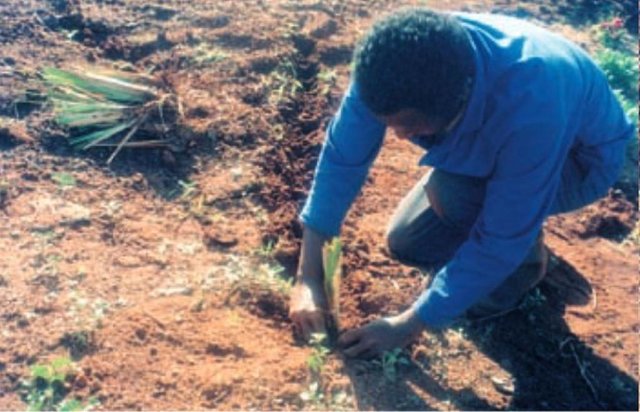
Self teaching [África do Sul]
Learning how to use vetiver grass as a vegetative conservation barrier through instructions from a booklet and hands-on practical experience.
- Compilador/a: Philippe Zahner
2. Descrição da tecnologia de GST
2.1 Descrição curta da tecnologia
Definição da tecnologia:
Contour lines of vetiver grass planted within fields of sugar cane, on stream banks and roadsides, to act as ‘hedges against erosion’.
2.2 Descrição detalhada da tecnologia
Descrição:
This example of vetiver grass barriers comes from a commercial farm in Kwa-Zulu Natal, South Africa, where sugar cane is grown on a large scale under a rainfall regime of around 1,000 mm per year. Vetiver grass (Vetiveria zizanioides), which had been growing naturally on the farm for years in isolated clumps, began to be used in 1989 to form vegetative hedges along the contour.
The purpose of these hedges is to protect the land from surface erosion by creating semi-permeable barriers, allowing excess runoff to filter through but holding back sediment. Infiltration is thus increased and moisture conserved in-situ. Although sugar cane in itself protects the soil quite well when the canopy is closed, after harvest on the moderate to steep slopes (10% to >30%) and erodible soils of the north coast of Kwa-Zulu Natal, extra protection is required. The vetiver system is supplemented by other soil conservation measures such as strip cropping, terraces, mulching and minimum tillage – all of which are used to some extent on this farm. Vetiver also helps by permanently marking the contour line, which then guides land preparation. In common with other vegetative barriers, vetiver lines lead to the formation of terraces over time, through the effect of tillage and water erosion between the strips.
Vetiver clumps are dug up and separated into slips (tillers), cut to a length of 10 cm and then planted 10–15 cm apart along the contour, also by stream banks, and by roadsides, just before the rains. This ensures good establishment. Single lines are used in this farm, though double lines are more effective at creating a hedge, and are the normal recommendation. Work starts at the top of the slope, and continues downwards. The cross-slope grass hedges are sited at 5 m vertical intervals on slopes of more than 10%, in lines about 200 m long. The cost of vetiver grass planting depends very much on slope (and thus the number of lines to be planted), availability of materials and labour.
Maintenance is very important, as vetiver often requires ‘gapping-up’ to keep the barrier dense, and it needs also to be cut back before the dry season to prevent it burning. The cut material can be used for mulching. Vetiver is poorly palatable, and therefore not useful as fodder. The maximum height of a vetiver hedge is kept down to approximately 50 cm. This minimises shading and competition, keeps the fire risk low, increases tillering (for production of vegetative splits) and ensures adequate density.
2.3 Fotos da tecnologia
2.5 País/região/locais onde a tecnologia foi aplicada e que estão cobertos nesta avaliação
País:
África do Sul
Região/Estado/Província:
KwaZulu/Natal
Especificação adicional de localização:
Lower Tugela district
Map
×2.6 Data da implementação
Caso o ano exato seja desconhecido, indique a data aproximada:
- menos de 10 anos atrás (recentemente)
2.7 Introdução da tecnologia
Especifique como a tecnologia foi introduzida:
- durante experiências/ pesquisa
Comentários (tipos de projeto, etc.):
The grass originally came to this country from Mauritius.
3. Classificação da tecnologia de GST
3.1 Principal/principais finalidade(s) da tecnologia
- Reduz, previne, recupera a degradação do solo
3.2 Tipo(s) atualizado(s) de uso da terra onde a tecnologia foi aplicada

Terra de cultivo
- Cultura perene (não lenhosa)
Principais plantações (colheitas para venda e consumo próprio):
major cash crop: sugar cane
Comentários:
Major land use problems (compiler’s opinion): The steep topography and shallow soils limit the types of land use possible e.g.. perennial grass cover (sugarcane or grazing) or commercial timber production. Annual cropping is not possible without major alteration to the landscape e.g. terracing.
3.3 Mais informações sobre o uso da terra
Abastecimento de água para a terra na qual a tecnologia é aplicada:
- Precipitação natural
Número de estações de cultivo por ano:
- 1
Especifique:
Longest growing period in days: 200; Longest growing period from month to month: Oct - April
3.4 Grupo de GST ao qual pertence a tecnologia
- Solo/cobertura vegetal melhorada
- Medidas de curva de nível
3.5 Difusão da tecnologia
Especifique a difusão da tecnologia:
- Uniformemente difundida numa área
Caso a tecnologia seja uniformemente difundida numa área, indique a área coberta aproximada:
- 1-10 km2
Comentários:
Total area covered by the SLM Technology is 8 km2.
The vetiver system has been applied on my own properties. Neighbouring farms have adopted other methods of conserving the soil. i.e. vegetative, agronomic and structural in various combinations (= farm)
3.6 Medidas de GST contendo a tecnologia

Medidas vegetativas
- V5: Outros
Comentários:
Main measures: vegetative measures
Secondary measures: agronomic measures, structural measures, management measures
Specification of other vegetative measures: grass strip as hedges
Type of agronomic measures: mulching, minimum tillage, contour ridging
3.7 Principais tipos de degradação da terra abordados pela tecnologia

Erosão do solo pela água
- Wt: Perda do solo superficial/erosão de superfície
- Wg: Erosão por ravinas/ravinamento

Erosão do solo pelo vento
- Et: Perda do solo superficial

Degradação da água
- Hg: mudança no lençol freático/aquífero
3.8 Redução, prevenção ou recuperação da degradação do solo
Especifique o objetivo da tecnologia em relação a degradação da terra:
- Reduzir a degradação do solo
- Recuperar/reabilitar solo severamente degradado
Comentários:
Secondary goals: rehabilitation / reclamation of denuded land
4. Especificações técnicas, implementação de atividades, entradas e custos
4.1 Desenho técnico da tecnologia
4.2 Especificações técnicas/ explicações do desenho técnico
Vetiver grass is planted as a vegetative barrier (hedge), on the contour at 5 metre vertical intervals within fields of sugarcane.
Location: Lower Tugela district. KwaZulu/Natal
Technical knowledge required for field staff / advisors: low
Technical knowledge required for land users: low
Main technical functions: control of dispersed runoff: impede / retard
Secondary technical functions: control of concentrated runoff: impede / retard, increase / maintain water stored in soil
Mulching
Material/ species: Sugarcane
Remarks: Full ground cover
Minimum tillage
Material/ species: Chemical crop eradication
Contour ridging
Material/ species: Planting lines ridged on contour
Vegetative measure: contour
Vegetative material: G : grass
Vertical interval between rows / strips / blocks (m): 5
Spacing between rows / strips / blocks (m): 2
Vertical interval within rows / strips / blocks (m): 0
Width within rows / strips / blocks (m): 0.5
Vegetative measure: Vegetative material: G : grass
Grass species: Vetiver grass
Slope (which determines the spacing indicated above): 20.00%
If the original slope has changed as a result of the Technology, the slope today is (see figure below): 20.00%
Gradient along the rows / strips: 0.00%
Other type of management: Cane is planted on suitability (slope, soil depth)
4.3 Informação geral em relação ao cálculo de entradas e custos
Especifique como custos e entradas foram calculados:
- por área de tecnologia
Indique o tamanho e a unidade de área:
ha
Especifique a moeda utilizada para os cálculos de custo:
- Dólares norte-americanos
Indique a média salarial da mão-de-obra contratada por dia:
2.00
4.4 Atividades de implantação
| Atividade | Tipo de medida | Periodicidade | |
|---|---|---|---|
| 1. | Plant with fertilizer & water | Vegetativo | Rainy season (Sept - Mrch) |
| 2. | Weed & gap plant | Vegetativo | |
| 3. | Cut back to promote tillering | Vegetativo | |
| 4. | Crop gradication | Gestão | Nov-Jan |
| 5. | Ridging of planting furrows | Gestão | +- 1-2 months before |
| 6. | Planting of sugarcane - fertiliser in furrow | Gestão | |
| 7. | Top dress fertiliser | Gestão | 9 week after planting |
| 8. | Herbicide application | Gestão | Anytime necessary after planting |
4.5 Custos e entradas necessárias para a implantação
| Especifique a entrada | Unidade | Quantidade | Custos por unidade | Custos totais por entrada | % dos custos arcados pelos usuários da terra | |
|---|---|---|---|---|---|---|
| Mão-de-obra | Plant and fertilize | persons/day/ha | 15,0 | 2,0 | 30,0 | 100,0 |
| Equipamento | hoe | ha | 1,0 | 4,0 | 4,0 | 100,0 |
| Material vegetal | Vetiver | cubic meter | 1,0 | 66,0 | 66,0 | 100,0 |
| Fertilizantes e biocidas | Fertilizer | ha | 1,0 | 40,0 | 40,0 | 100,0 |
| Custos totais para a implantação da tecnologia | 140,0 | |||||
Comentários:
Duration of establishment phase: 24 month(s)
4.6 Atividades recorrentes/manutenção
| Atividade | Tipo de medida | Periodicidade/frequência | |
|---|---|---|---|
| 1. | minimum tillage | Agronômico | mulching at harvest |
| 2. | minimum tillage | Agronômico | |
| 3. | mulching at harvest | Agronômico | April-Dec / Every year |
| 4. | Weed | Vegetativo | /3 times |
| 5. | Gap plant | Vegetativo | /Once |
| 6. | Weed | Vegetativo | /When required |
| 7. | Spray for creeper grasses | Vegetativo | /When required |
| 8. | Plaint unwanted trees etc. | Vegetativo | /When required |
| 9. | Harvest sugarcane | Gestão | / Annual |
| 10. | Trash management (mulch spreading) | Gestão | After harvest completed / Annual |
| 11. | Fertiliser application | Gestão | 1-2 months after harvest / Annual |
| 12. | Herbicide application | Gestão | Required / Annual |
| 13. | Hand weeding | Gestão | / Annual & when required |
4.7 Custos e entradas necessárias pata a manutenção/atividades recorrentes (por ano)
| Especifique a entrada | Unidade | Quantidade | Custos por unidade | Custos totais por entrada | % dos custos arcados pelos usuários da terra | |
|---|---|---|---|---|---|---|
| Mão-de-obra | Maintaining plot | persons/day/ha | 5,0 | 2,0 | 10,0 | 100,0 |
| Equipamento | hoe | ha | 1,0 | 4,0 | 4,0 | 100,0 |
| Fertilizantes e biocidas | Biocides | ha | 1,0 | 5,0 | 5,0 | 100,0 |
| Fertilizantes e biocidas | Slips | ha | 1,0 | 6,0 | 6,0 | 100,0 |
| Custos totais para a manutenção da tecnologia | 25,0 | |||||
Comentários:
Machinery/ tools: 1 hoe
1) Labour,
2) Transport,
3) Price of grass,
4) Fertiliser,
5) Equipment
4.8 Fatores mais importantes que afetam os custos
Descreva os fatores mais determinantes que afetam os custos:
1) Labour,
2) Transport from nursery to field,
3) The steeper the gradient the more contour lines of vetiver grass will be used,
4) Fertiliser
5. Ambiente natural e humano
5.1 Clima
Precipitação pluviométrica anual
- <250 mm
- 251-500 mm
- 501-750 mm
- 751-1.000 mm
- 1.001-1.500 mm
- 1.501-2.000 mm
- 2.001-3.000 mm
- 3.001-4.000 mm
- > 4.000 mm
Especificações/comentários sobre a pluviosidade:
Not usually less than 900 and not usually more than 1200
Zona agroclimática
- Subúmido
Thermal climate class: subtropics
Thermal climate class: temperate
5.2 Topografia
Declividade média:
- Plano (0-2%)
- Suave ondulado (3-5%)
- Ondulado (6-10%)
- Moderadamente ondulado (11-15%)
- Forte ondulado (16-30%)
- Montanhoso (31-60%)
- Escarpado (>60%)
Formas de relevo:
- Planalto/planície
- Cumes
- Encosta de serra
- Encosta de morro
- Sopés
- Fundos de vale
Zona de altitude:
- 0-100 m s.n.m.
- 101-500 m s.n.m.
- 501-1.000 m s.n.m.
- 1.001-1.500 m s.n.m.
- 1.501-2.000 m s.n.m.
- 2.001-2.500 m s.n.m.
- 2.501-3.000 m s.n.m.
- 3.001-4.000 m s.n.m.
- > 4.000 m s.n.m.
Comentários e outras especificações sobre a topografia:
Slopes on average: Also moderate, mostly in footslopes & valleys (steep sides)
Landforms: Also ridges
Altitudinal zone: 360 - 380 m a.s.l.
5.3 Solos
Profundidade do solo em média:
- Muito raso (0-20 cm)
- Raso (21-50 cm)
- Moderadamente profundo (51-80 cm)
- Profundo (81-120 cm)
- Muito profundo (>120 cm)
Textura do solo (solo superficial):
- Grosso/fino (arenoso)
- Médio (limoso, siltoso)
Matéria orgânica do solo superficial:
- Alto (>3%)
- Médio (1-3%)
Caso disponível anexe a descrição completa do solo ou especifique as informações disponíveis, p. ex. tipo de solo, PH/acidez do solo, nitrogênio, capacidade de troca catiônica, salinidade, etc.
Soil depth on average: Als very shallow. But mostly moderately deep
Soil texture: Mostly medium
Soil fertility is medium
Topsoil organic matter: Mostly medium and high in very small areas
Soil drainage / infiltration is good - medium
Soil water storage capacity is medium - high
5.6 Características dos usuários da terra que utilizam a tecnologia
Orientação de mercado do sistema de produção:
- Comercial/mercado
Rendimento não agrícola:
- Menos de 10% de toda renda
Nível de mecanização:
- Trabalho manual
- Mecanizado/motorizado
Indique outras características relevantes dos usuários da terra:
Market orientation of production system: All commercial
Level of mechanization: Manual labour for fertilising, weeding, planting, harvesting and mechanised for crop extraction
5.7 Média da área de terra própria ou arrendada por usuários da terra que utilizam a tecnologia
- < 0,5 ha
- 0,5-1 ha
- 1-2 ha
- 2-5 ha
- 5-15 ha
- 15-50 ha
- 50-100 ha
- 100-500 ha
- 500-1.000 ha
- 1.000-10.000 ha
- > 10.000 ha
Comentários:
Per farm where SWC technology is used
5.8 Propriedade de terra, direitos de uso da terra e de uso da água
Propriedade da terra:
- Indivíduo, não intitulado
Direitos do uso da terra:
- Indivíduo
6. Impactos e declarações finais
6.1 Impactos no local mostrados pela tecnologia
Impactos socioeconômicos
Produção
Produção agrícola
Área de produção
Gestão de terra
Renda e custos
Rendimento agrícola
Impactos socioculturais
Instituições nacionais
Conhecimento de GST/ degradação da terra
Impactos ecológicos
Ciclo hídrico/escoamento
Drenagem de excesso de água
Solo
Umidade do solo
Cobertura do solo
Perda de solo
Clima e redução de riscos de desastre
Risco de incêndio
Comentários/especificar:
Contains a lot of oil, only when mature (after 2 years) but does not affect the roots
Velocidade do vento
Comentários/especificar:
Row spacing
Outros impactos ecológicos
demarcates the contour
Comentários/especificar:
The planting is aligned for next planting
longer last of crop (sugarcane)
Comentários/especificar:
From 8-12 cuttings before replanting sugarcane (+-15 years); 3000-3500 R/ha cost for replanting the sugarcane.
6.2 Impactos externos mostrados pela tecnologia
Caudal confiável e estável em período seco
Cheias de jusante
Sedimentação a jusante
Poluição de água subterrânea/rio
Sedimentos transportados pelo vento
6.4 Análise do custo-benefício
Como os benefícios se comparam aos custos de implantação (do ponto de vista dos usuários da terra)?
Retornos a curto prazo:
neutro/balanceado
Retornos a longo prazo:
positivo
Como os benefícios se comparam aos custos recorrentes/de manutenção(do ponto de vista dos usuários da terra)?
Retornos a curto prazo:
positivo
Retornos a longo prazo:
muito positivo
6.5 Adoção da tecnologia
- mais que 50%
Se disponível, determine a quantidade (número de unidades familiares e/ou área abordada):
3 households
Entre todos aqueles que adotaram a tecnologia, quantos adotaram espontaneamente, ou seja, sem receber nenhum incentivo material/pagamentos?
- 90-100%
Comentários:
100% of land user families have adopted the Technology without any external material support
3 land user families have adopted the Technology without any external material support
Comments on spontaneous adoption: estimates
There is a little trend towards spontaneous adoption of the Technology
Comments on adoption trend: Some local growers are experimenting with the vetiver system or with vetiver grass used in other applications (gullies, road embankments, etc.)
6.7 Pontos fortes/vantagens/oportunidades da tecnologia
| Pontos fortes/vantagens/oportunidades na visão do usuário da terra |
|---|
| The author is the land user |
| Pontos fortes/vantagens/oportunidades na visão do/a compilador/a ou de outra pessoa capacitada |
|---|
|
When planted correctly, vetiver forms a dense, permanent hedge which retains soil and water so increases crop yield How can they be sustained / enhanced? Make sure there are no gaps between slips in order to maintain a dense vegetative barrier. |
|
It has a strong fibrous root system that penetrates and binds the soil to a depth of up to 3 meters and can withstand the effects of tunnelling and cracking. Its many uses e.g.. Thatching, mulching etc. |
| Vetiver grass seed is sterile so it doesn’t spread. |
| Not very competitive to crops growing alongside. |
|
The cut material can be used for mulching and has multiple secondary uses (thatching, basket making, etc). Once established it can withstand periods of drought and waterlogging. It is also resistant to grazing and to most pests and diseases. Adaptability: can be planted in various environments and grows well in most soil types. Depending on the availability of planting materials and the spacing adopted, can be relatively cheap and easy to establish and – once well established – vetiver requires minimal maintenance. |
6.8 Pontos fracos, desvantagens/riscos da tecnologia e formas de superá-los
| Pontos fracos/desvantagens/riscos na visão do usuário da terra | Como eles podem ser superados? |
|---|---|
| The author is the land user |
| Pontos fracos/vantagens/riscos na visão do/a compilador/a ou de outra pessoa capacitada | Como eles podem ser superados? |
|---|---|
| Sugarcane residue is often blown against the hedges & this can form a thick blanket thus preventing ratooning of crop | Strategic/controlled burning at end of growing season or trimming back |
| The grass burns very easily when mature, due to its density | Keep chemicals off vetiver. |
| Susceptible to certain chemicals used in sugar cane | Establish own nursery. |
| Planting material expensive to buy: therefore costs increase considerably unless farmer has own nursery | |
| Takes time to plant a large area (in this case 2.5 ha per year). |
Links e módulos
Expandir tudo Recolher tudoLinks

Self teaching [África do Sul]
Learning how to use vetiver grass as a vegetative conservation barrier through instructions from a booklet and hands-on practical experience.
- Compilador/a: Philippe Zahner
Módulos
Não há módulos


